
| Chequered or Saltbush Blue (one synonym : Cupido fasciola Tepper, 1882) POLYOMMATINI, POLYOMMATINAE, LYCAENIDAE, PAPILIONOIDEA | (donherbisonevans@yahoo.com) and Stella Crossley |
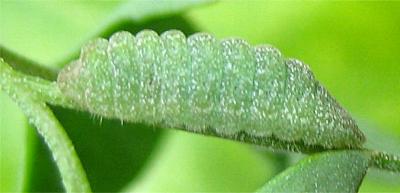
(Photo: courtesy of Wes Jenkinson)

| Chequered or Saltbush Blue (one synonym : Cupido fasciola Tepper, 1882) POLYOMMATINI, POLYOMMATINAE, LYCAENIDAE, PAPILIONOIDEA | (donherbisonevans@yahoo.com) and Stella Crossley |

(Photo: courtesy of Wes Jenkinson)
This Caterpillar is green with a dark dorsal stripe bordered by yellow. It is covered in small white warts. It feeds on various types of Saltbush (CHENOPODIACEAE), for example :
as well as
The caterpillar is inclined to leave the veins of the leaves uneaten, which is useful when hunting the beastie. It is usually attended by small black ants of various genera including :
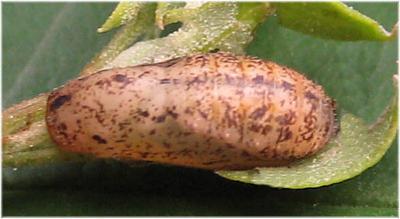
The caterpillar grows to a length of about 1 cm. The pupa is green with brown markings and has a length of about 0.7 cm. It is usually attached to the foodplant.
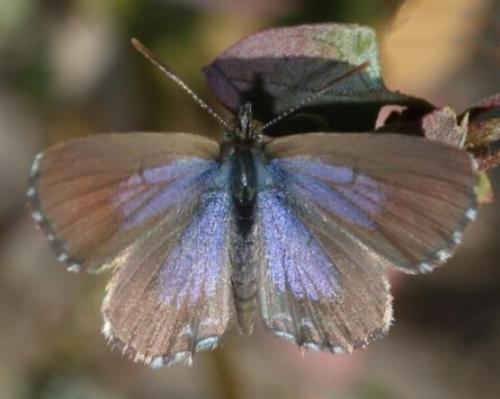
The adults are brown on top with blue central areas, and chequered margins.
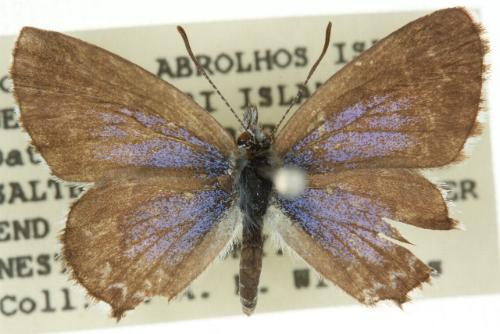 <
<Underneath, they are pale brown, with white spots and dashes. The butterflies have a wing span of about 2 cms.
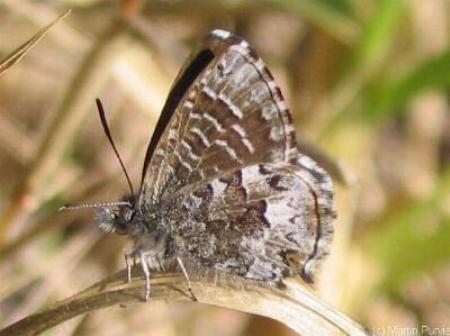
The eggs are pale green and flattened, and covered in a microscopic diamond-shaped lattice of ribs. The eggs have a diameter of about 0.6 mm. The eggs are laid singly on flower buds and leaves of a foodplant.
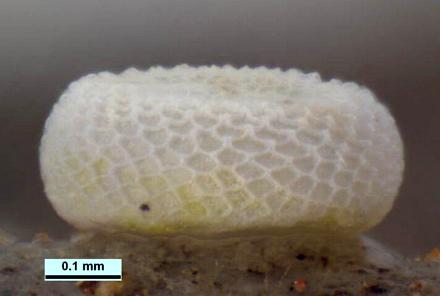 <
<The species has been found in Australia, especially in the non-tropical areas, as several races, including :
Further reading :
Michael F. Braby,
Butterflies of Australia,
CSIRO Publishing, Melbourne 2000, vol. 2, pp. 813-814.
Russel Denton & John T. Moss,
Saltbush Blue and Samphire Blue butterflies at Boondall Wetlands,
Butterflies and Other Invertebrates Club,
Metamorphosis Australia,
Issue 52 (March 2009), pp. 8-9.
Kelvyn L. Dunn,
Winter butterfly observations near the Melbourne CBD,
Butterflies and Other Invertebrates Club,
Metamorphosis Australia,
Issue 57 (June 2010), pp. 19-26.
Gottlieb August Wilhelm Herrich-Schäffer,
Neue Schmetterlinge aus dem "Museum Godeffroy" in Hamburg,
Stettin Entomologische Zeitung,
Volume 30 , Parts 1-3 (1869), p. 74, No. 32.
Wealey Jenkinson,
Life history notes on the Saltbush Blue, Theclinesthes serprntata serpentata
(Herrich-Schaffer, 1869) Lepidoptera: Lycaenidae),
Butterflies and Other Invertebrates Club,
Metamorphosis Australia,
Issue 81 (June 2016), pp. 19-21.
 caterpillar |  butterflies |  Lepidoptera |  moths |  caterpillar |
(updated 30 May 2008, 11 September 2025)